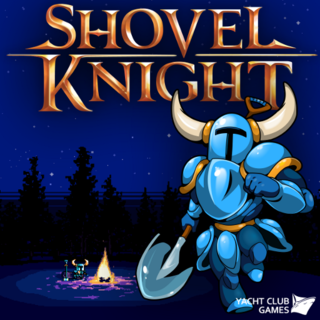INTRO:
There had been three expansions to Shovel Knight since its debut. All of them are 2D platformers in the vein of Mega Man and Duck Tales. While Shovel Knight has a considerable following, Yacht Club Games can only do so many expansions before jaded familiarity sets in. King of Cards tried to do something different, but not everyone appreciated having a card game in a 2D platformer title.
Thus, there is Showdown, which is intended to fulfil a yearning that the developer had all along, which is to have almost every combat-capable character be playable. This expansion also sports gameplay that is different, while also retaining elements of 2D platforming.
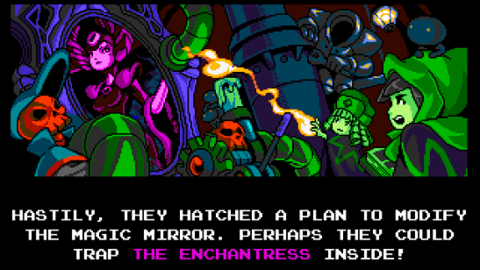
PREMISE:
King of Cards is the story campaign that showed the limits to what Yacht Club Games can do with prequels and retcons before an impression of disconnection begins to set in. Showdown would not show many new things, but would reveal the motivations of the characters and their relationships with each other.
Timeline-wise, the narrative of this expansion has been squeezed somewhere in the transition to the finale of Spectre of Torment. However, the events in Showdown are not instigated by the Spectre Knight, but rather the NPCs that he has befriended. (Though to call them his friends is a bit of an overstatement. Spectre Knight may have made use of their services and helped out one or two of them, but he is a terse acquaintance at best.)
Somehow inspired by his outrage at the Enchantress, they decided to rebel. Those among them that have knowledge of the dark arts came up with a hasty plan to rig the Mirror of Fate, a device that the Enchantress has been using to move her forces around. It was rushed work, however.
When they activated the modified Mirror, many of the prominent characters in the series were transported to the artificial realms that have been made by the corrupted Mirror. The Mirror also created parallel worlds, or rather tangible reflections of the world that the characters live in.
Thus, this is the narrative excuse for the presence of a mishmash of levels, together with copies of the characters that a follower of the series has come to know. Their ordeal is ultimately inconsequential, because it might as well has happened in the blink of an eye due to the space-time magical anomaly that the Mirror has created.
SMASHING GAMEPLAY:
Players who have experience with the Smash Bros IP and games with similar concept would recognize the gameplay in Showdown almost immediately.
Contenders, human or CPU-controlled, have to vie with each other in matches. These matches take place in compact arrangements of the locales that have been seen in the previous expansions. For conformity with the genre that Smash Bros has established, these places would be called “stages”. (The same term is used in-game.)
The contenders have to achieve the objectives that have been set for the matches. These objectives can be about eliminating each other or collecting gems. However, how they go about doing so can be influenced by the conditions of the stages and how the players are pitted against each other.
LIFE AND LIVES:
Instead of a percentage counter that determines how much knockback that would be caused by hits, there is the usual life meter with pips that followers of Shovel Knight would recognize.
These health meters are far shorter than those seen in the story campaigns, however. Indeed, a few hits are all that are needed to knock any of them out. If they are knocked out, they lose a “life”. If a character loses all lives, he/she is out of the match and definitely will not be winning it. In the case of the player character, he/she will always have finite lives; it is up to the player to conserve these as much as possible.
As for CPU-controlled contenders, they may have unlimited lives. This is especially so for matches that are about collecting gems, though not always. This was implemented to compensate for the fact that CPU-controlled contenders would never improve their skill beyond what they have been scripted to achieve.
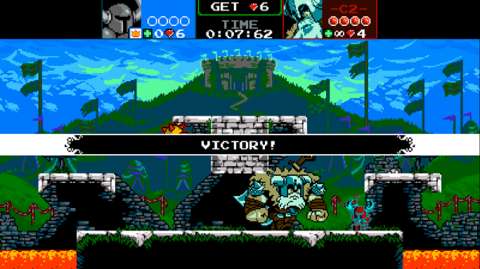
CONTACT DAMAGE:
Contenders cannot damage each other through contact, at least by default. Contact with hazards or hostile NPCs will inflict contact damage, however.
There is a power-up that grants contact damage for a contender, in addition to invulnerability to any attacks from the other contenders.
HIT-REACTIONS:
Every character has hit-reactions now. In the case of the protagonists of the four story campaigns, they already have animations for these. New ones were made for the other characters, including those that have been bosses in the story campaigns.
These hit-reactions occur together with knock-backs. Some characters have knockbacks with longer distances than others, though most of the distances are overall rather short. It would take a major misstep for a contender to get knocked back into hazards. This is perhaps much appreciated, especially by those who have been frustrated by the hit-reactions of the player characters in the story campaigns.
There are some match conditions that greatly increase the knockback distance, however. The player is warned of these before the start of the matches.
INVULNERABILITY FRAMES:
The hit-reactions are coupled with invulnerability frames. The frames can last well after the characters have recovered from the hit-reactions, so there is an opportunity for the characters to get out of harm’s way.
The invincibility frames will not prevent characters from being knocked out if they come into contact with instant-death hazards, like lava flows or death pits. (There are next to no stages with spike hazards, however.) However, since they are rendered invulnerable and the frames last past their recovery times, getting into such trouble is very much a fault on the controlling player’s part.
CHARACTERS WITH REBOUNDS:
Some characters have rebounding attacks. This includes Shovel Knight, King Knight and Spectre Knight, i.e. the player characters that have exhibited these in the story campaigns. Black Knight also exhibit this, even though he did not as a boss in the story campaigns.
However, since the contenders get considerable invincibility frames, rebounding off enemies and back onto them is not doable. They do get considerable air-time, however, so they could land on another enemy instead.
Furthermore, since the characters pass through each other, it is possible for rebounding characters to pass across the top of the sprites of competitors. If this happens, this counts as having hit them with the rebound, and another rebound happens. Thus, it is possible for a skilled opportunist to hit multiple enemies that are in a fray.
Most characters with rebounding attacks do not have multiple jumps. The exception is Spectre Knight, which is one of the most mobile characters in the game.
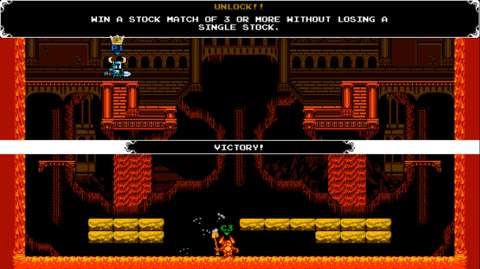
CHARACTERS WITH MULTIPLE JUMPS:
Some characters have multiple jumps. This includes Plague Knight, and even Spectre Knight. Propeller Knight also has a double jump, which immediately has him going into his gliding animation. As to be expected of multiple jumps, these allow the characters to change their jump directions in mid-air, which is something that can be very useful in Smash-like gameplay.
Characters with multiple jumps generally do not have rebound attacks. Again, Spectre Knight is an exception. However, he has some setbacks, namely a vertically narrow hitbox for his scythe slashes, so players who use him have to be precise with their manoeuvres so that he can his rivals.
RANGED ATTACKS:
Interestingly, every character has a ranged attack, or to be more precise, an attack that does not require them to be right next to opponents to hit them. For most characters, this is their alternate attack, though some have it as their primary attack.
For example, Plague Knight’s primary attack is to hurl bombs. (His bombs follow a straight trajectory in Showdown, by the way.) For another example, Shield Knight always tosses her large shield as her primary attack, if she has it on hand.
At best, these attacks are meant for area-denial. Getting hit by one is generally the penalty for carelessness, because the ranged attacks are very obvious and involve projectiles that are not particularly fast. Furthermore, these projectiles can be deflected with any attacks.
That said, contenders who dodge ranged attacks would have their avenues of escape and approach reduced. Not unlike what cunning players would do in Smash-like titles, having opponents do this would set them up for follow-up attacks.
As for the characters’ ranged attacks, they can vary even more than their primary attacks. For example, titular Shovel Knight has his Flare Wand for firing a medium-range and medium-speed fireball, whereas Polar Knight creates a large snow boulder out of nowhere and has it rolling.
CHARGED ATTACKS:
Some characters have the ability to charge up one of their attacks (usually their primary) before unleashing it. For example, the Black Knight can charge up his primary attack to launch a large purple fireball over a long distance and at considerable speed.
Typically, these attacks are powerful. Therefore, the charging has an obvious visual indicator: the characters’ sprites flash. The charges are lost if they are hit, so the characters that are charging attacks will not want to keep them for too long.
For some characters, these charged attacks are as much a form of movement as they are attacks. This is the case for Plague Knight, whose blast-jump returns as his charged attack in Showdown.
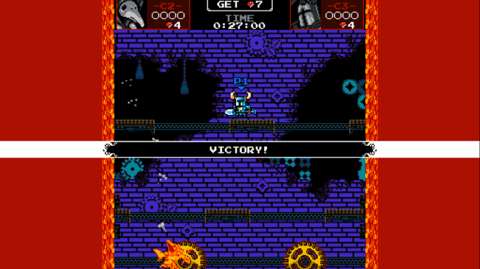
PARRY:
All characters have the ability to “Parry”. Like charged attacks, this requires them to charge up. However, they must stand still and they will have obvious animations that they are doing so. A poorly timed Parry would open them to attacks.
When the Parry is fully charged – which happens after around two seconds or so – the Parry is unleashed. It cannot be held any further. The Parrying character releases a radial shockwave that originates from the character. Any opponent that is caught in this shockwave will be repelled outside the radius of the shockwave.
The repelled characters do not take any damage, but their controlling players lose control of them momentarily. Since these repelled characters do not have invincibility frames, they can be hit just after they have been repelled.
Some characters’ Parry moves are different from others. The most notable of these is Polar Knight’s Parry, which protects him from rebound attacks, even while he is charging up the Parry.
POWER-UPS, IN GENERAL:
For better or worse, there are power-ups that randomly appear on-screen. These are not unlike those in the Smash titles. Players who do not like random factors in the gameplay would not like their presence in this game.
The hosting player can choose to disable power-ups in the Battle mode, which lets the hosting player alter the match conditions. However, the Story mode does not allow this, unless the match to be had has been designated to have no power-ups at all.
Getting these power-ups is not as easy as coming into contact with them. The power-ups appear on-screen in bubbles, which have to be broken with attacks. This can open a character to attacks from others after the character has broken a bubble. Fortunately, for most power-ups, breaking the bubbles that they are in automatically claims them for the character that released them.
Certain power-ups will be described here, because they have properties that have considerable impact on gameplay.
BOMBS:
Bombs are not exactly power-ups that are beneficial to the character that broke them out of their bubbles. Only the bandolier of power-ups does, which gives the ability for a contender to leave behind a bomb after every jump; the bomb does not harm the contender, but does harm everyone else.
The other bombs have bubbles that actually cause hit-reactions in the characters that break them; no damage is inflicted, however. Nevertheless, the released bombs will start their fuses and will harm anyone caught in their blast when they detonate.
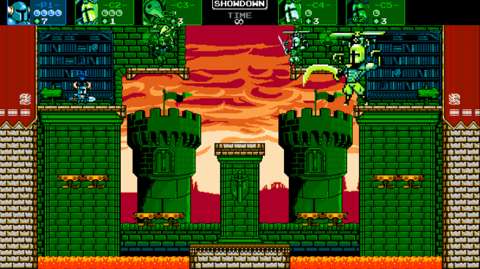
FOOD:
As in the story campaigns, food restores health in Showdown. However, food does not appear often during the matches.
When they do appear, they appear from covered dishes. The covered dishes do not always contain food though; they may contain bombs instead, which can be unpleasant. Fortunately, the fuses of the bombs only start after the bombs have been revealed.
Food like carrots and apples stay where they are when they are revealed. However, the turkeys might sprout wings and fly around, which complicate their retrieval. Indeed, the turkeys might even linger over dangerous spots like death-pits and lava. On the other hand, turkeys that are flying do not disappear after a while, unlike food that stays where it is.
GEMS:
Many matches require the retrieval of gems. Gems are not initially in the stage; their arrival is indicated with the appearance of rings of stars. The rings shrink as the countdown to their appearance goes down.
The gems then appear as cut rubies that are suspended in mid-air. These gems are immediately available for any contender to collect. In some match types, such as the horizontal auto-scrolling state that is the Flying Machine, the gems may appear in bubbles. These bubbles are made of hard glass that have to be broken before the gems are released.
LOST GEMS:
When characters are knocked out, they lose at least one gem. If their gem count is already close to the count that is needed to win the match, they lose two. The gems pop out of their sprites as they are undergoing their knocked-out (KO) animations. These gems are up for grabbing by anyone.
INVINCIBILITY FRAMES:
Contenders that are under the effect of invincibility frames cannot collect any gems whatsoever. Irritating noises play when they attempt to do so. This can seem frustrating at first, but this is necessary in order to prevent unscrupulous players from exploiting the invincibility frames.
GEMS THAT FALL INTO HAZARDS:
Gems that fall into instant-death hazards are not entirely lost. They gain little angel wings, and also rebound away from the hazards in the opposite direction. Then, they hover in the air after they slow down. The gems can be retrieved by anyone.
However, if the winged gems are somehow forced into instant-death hazards again – which can happen in auto-scrolling stages – the gems are permanently lost.
TIMERS:
Matches will not go on forever. Even the longest last for little over two minutes.
When the timer runs out, the contender with the greatest number of gems win, if the match objective is about collecting gems. In matches that are free-for-all’s, collecting many gems and staying out of the way of enemies until the timer runs out is a practical albeit cowardly tactic. Alternatively, the contender with the most lives would win if gem-collection is not the objective.
In certain matches with certain conditions, such as those that pit the player against unlimited waves of CPU-controlled opponents, time is against the player. Certain matches have power-ups that can extend the timer. However, these power-ups become increasingly rarer as time goes by. Thus, the end of the match is guaranteed.
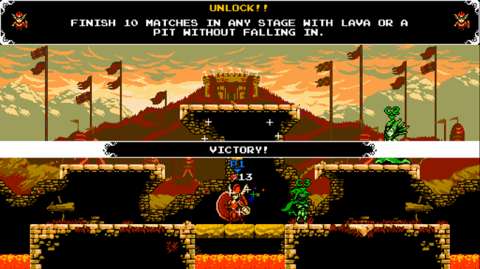
STAGE HAZARDS:
Almost all stages have pitfalls, i.e. instant-death fall hazards. Thus, the player needs to be mindful about these hazards wherever they occur.
The stage in the Lost City has lava flows. The lava flows also occur across the vertical edges of the screen, thus posing more hazards than pitfalls. Unfortunately, the gimmick of turning lava into bouncy jelly does not appear in this game.
There are no spike hazards, which is a peculiarity in a game that has included so many of these hazards thus far.
Other than these fixtures, hazards are things that the contenders introduce into the stage, typically through power-ups.
STAGE WRAP-AROUNDS:
Most stages have wrap-around edges. Usually, the indication for this is that the stage appears to be perfectly symmetrical.
Wrap-around edges allow characters to move across an edge and reappear from the opposite edge. These can be used to great effect, especially against CPU-controlled opponents that do not seem to be aware of them.
Most wrap-around edges are vertical, i.e. those allowing for horizontal crossings. Vertical wrap-around edges are few and far between, though there are some, such as the stage that takes place in the Lich Yard. Since gravity is always active, these wrap-around edges can be used for surprise attacks.
PERCY’S CHALLENGE:
For whatever reason, Percy is the star of a mini-game involving him and his mechanical contraptions. He is using these to transport bales of hay, bombs and clocks around, as well as hay that may or may not have come out of the experiments at the Potionarium. It is unclear as to why he thinks that such handling of materials is a good idea, but that is the set-up for this otherwise entertaining challenge.
The player’s goal is to knock out as many bales of hay as is needed to reach the target score within the given time limit. There are many chances to extend the timer, but the targets move increasingly faster over time and/or as the player accumulates points.
Eliminating a chain of targets fills up a combo meter, which multiplies the points that the player would score upon eliminating further targets. Removing entire chains also extends the timer. The combo meter decays over time and when the player character takes damage. Therefore, the player has an incentive to be efficient and skilful.
The solid platforms at the bottom of the screen happen to disappear as time goes by. Thus, the player would have to learn how to keep as much air-time as possible.
In hindsight, this challenge was put in place to train the player on how to respond to incoming targets and eliminating them. Indeed, a skilled player could accumulate a high multiplier and possibly complete the challenge under a minute.
It is not entirely about skill, for better or worse. The targets will come into the screen from random directions, take randomized paths and have randomized combinations of targets. For example, it is possible for the player to get lucky enough to have many targets on screen when a powered-up hay bale appears conveniently close to the player character.
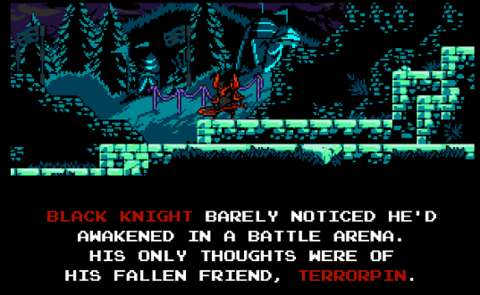
UNLOCKING CHARACTERS:
Not all characters are available for the player to use from the get-go, though the player will sometimes see CPU-controlled opponents using characters that the player has yet to have access to.
For example, the Knights that were exclusively bosses in the story campaigns are not all unlockable from the start. To unlock them, the player has to complete Spectre Knight’s and King Knight’s story branches.
That said, the conditions to unlock characters are relatively straightforward. Each subsequent unlockable character so happens to be a “rival” character of sorts in the story branch of an already-unlocked character. For example, Shield Knight is Shovel Knight’s “rival” in his branch, so completing his branch unlocks Shield Knight. Shield Knight also begins to appear more frequently as a CPU-controlled character.
UNLOCKING PALETTE SWAPS & ALTERNATE SPRITES:
Unlocking palette swaps and alternate sprites for the characters is a different matter. The conditions for unlocking these are much more complicated than merely beating story branches. There is in-game documentation that shows what can be unlocked and the conditions for doing so, but not every detail is shown to the player.
MIRROR OF FATE:
The Mirror of Fate is the finale for each story branch. It is practically a boss fight, which can seem daunting in Showdown because the player character does not have a long life meter.
The boss fight plays out the same way for every character’s story branch. Therefore, the player only needs to be familiar with the player character enough to know how to use him/her to defeat the mirror. No character is disadvantaged, though it is notable that the player must be aware of how to use their ranged and aerial attacks in order to reach the Mirror’s only vulnerable spot.
DIFFICULTY RATINGS:
The player can set the difficulty rating of CPU-controlled opponents and the challenge levels of the story branches.
The default “Normal” has the game throwing up a considerable challenge, especially to players who are new to Smash-like gameplay. Indeed, at “Normal”, CPU-controlled opponents are aware of their characters’ capabilities and the elements of the stage that they are in.
“Hard” enables more scripts for the decision-making of CPU-controlled opponents. The processing of their scripts is also completely removed of any otherwise deliberately implemented delays. This makes them substantially more aggressive and vicious. Furthermore, the player character has a shorter life meter and fewer spare lives.
In contrast, “Easy” is as easy as it sounds. CPU-controlled opponents have many of their scripts hobbled. There are frequent delays in the processing of their scripts, which can cause them to just stand where they are and do nothing. They also have less health and less lives. CPU-controlled team-mates are, however, not affected by the downgrading.
These ratings also affect the boss fight against the Mirror of Fate. At “Normal”, the Mirror is an aggressive opponent, especially in the first phase which is about collecting gems (to somehow defeat the mirror). At “Easy”, the Mirror is laughably placid throughout most of the first phase.
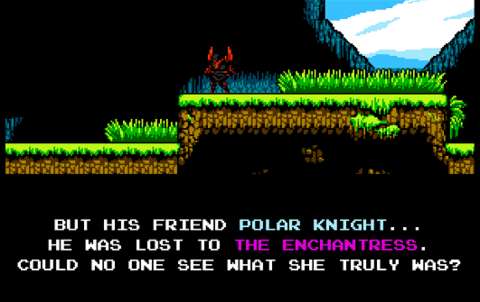
VISUAL DESIGNS:
Since Showdown is made using the same engine as the other Shovel Knight expansions, it would be using 2D sprite-based visuals too.
The top of the screen is reserved for the portraits, life meter, lives and gem counters of the contenders. However, keeping an eye on these displays can be rather strenuous, considering that the player should be observing the action going on-screen instead.
Therefore, thankfully, there are copies of the health meters and gem counters over every contender’s sprite. These appear whenever the contenders take damage or retrieve gems. These displays eventually fade away if they have not been taking damage or collecting gems for a while, but this is not likely to happen if the match is heated.
The sprites of the characters are substantially different enough to make them almost immediately recognizable. The most notable of them is Mona’s sprite. She is not wearing the single-piece gown that she has in Plague of Shadows and she does not have the cape either. This was likely the case so as not to have her sprite look similar to that of the Enchantress’.
PALETTE SWAPS & MIRROR MATCHES:
Yet, if this was indeed the reason for Mona’s redesign, then this design policy is not implemented thoroughly. This is because more than one player – human-controlled or otherwise – can pick and use the same character. (The narrative explains this away as the corrupted Mirror of Fate making copies of everyone.)
When the same characters are used, the game changes their colour palettes. It might use their gender-swapped sprites if they have any, but not every character has a gender-swapped sprite in Showdown. Even so, the in-game sprites for the two genders of the same character do not look very different from each other anyway.
Of course, all these would not be an issue to a player that is not colour-blind, but it will be to those that are. There are labels on top of the sprites of the characters, but they are presented in pixelated retro font. If the sprites of the same character come together in a brawl, it might be tough for a colour-blind player to figure which sprite is which player’s when they come apart.
MORE ANIMATIONS:
Practical issues aside, there are plenty of entertaining visuals to be seen from the characters. The boss characters, in particular, are sporting a lot more animations in Showdown than they had before in the story campaigns. These additional animations are mainly for cosmetics, such as the taunts that the characters can make (for nothing beneficial, really). Most are oddball, such as Polar Knight biting off a piece of meat that he took out from somewhere on his person.
As for the protagonists of the story campaigns, most of their animations have been reused (together with most of their combat capability).
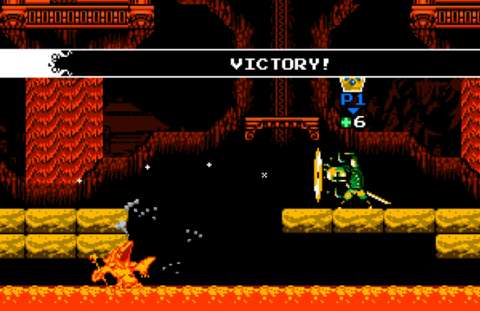
SOUND DESIGNS:
Showdown mostly reuses the tracks that Jake Kaufmann has composed for the story campaigns. There are some new ones of course, such as the track for the main menu of Showdown.
When a contender is close to victory or when the timer is running out, the music changes to the “Sudden Death” track; that track also plays when Sudden Death rules actually occur. This is a useful indicator, because the player’s eyes would likely be following the contenders and their environs.
There are still no voice-overs, though Showdown does reuse sound clips for occurrences such as Black Knight’s signature laugh. The game also reuses the sound effects that have been heard in the story campaigns.
LOCAL-ONLY MULTIPLAYER:
For better or worse, Showdown is local-only when it comes to multiplayer matches. This is perhaps to be expected – and lamented – because many indie developers do not have the skills or resources to implement online features. Yacht Club Games is not an exception.
SUMMARY:
Showdown would be the last expansion for Shovel Knight. This is perhaps fitting, because there can only be so much 2D platforming that can be had before a jaded follower of the series would get tired of more of the same. It might not hold a candle to the likes of Smash Bros or even indie titles like Rivals of Aether (in which Shovel Knight himself does get a cameo). However, it does do something different from the story campaigns and it does showcase the other major characters of the IP. Playing it will not be a waste of time, even for players who do not follow the Smash-like scene.
